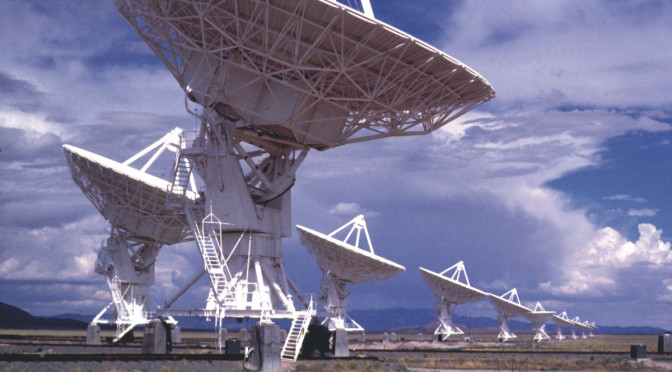I was wondering about the feasibility of projects such as SETI (Search for Extraterrestrial Intelligence). Given the universe is so enormous my guess would be that it’s rather unlikely we would ever hear from any other civilizations, ever.
Size of the universe
So, how large is the universe?
First we have to distinguish between the observable universe and the universe per se.
The observable universe has a volume of 3.4×1080 m3 according to Wikipedia. However, according to a WMAP analysis the actual universe is at least 21 times larger than the observable universe. This gives the actual universe a volume of 7×1081 m3. At least.
Distance between points
The following equation calculates the mean distance (D) between two neighbouring points, given N points in a shape (sphere or cube) with volume V. (It’s from GURPS-space, likely an approximation, but these equations don’t seem to grow on trees, Google or no Google):
D = 1.12 × (V/N)0.25
Given this formula we can determine the likely distance between randomly located civilizations in the universe. All we need to do is determine the number of civilizations we think exists.
Let’s say there are a million (1 000 000) intelligent, radio transmitting, civilizations out there. Given the above equation there should be only some 1.02×1019 meters between civilizations (or roughly 1 100 light years).
I seem to have been proven wrong! Even if there’s only 1 000 intelligent species out there the mean distance becomes some 6 000 light years.
What is the likelihood of 1000 intelligent civilizations?
The observable universe is calculated to contain some 70 billion trillion stars (7×1022). So, just in the observable universe a 1000 intelligent civilizations would mean one per 7×1019 stars, or a chance, per solar system, of 1×10-17% of there being an intelligent civilization there.
I wouldn’t call that a particularly high chance – which in this case means that a 1000 civilizations in the universe may be a very low number…
Now given that the whole universe is calculated to be 21 times larger than the observable universe, just multiply the number of stars with 21 (1.5×1024), i.e. one civilization per 1.5×1021 stars or a chance, per solar system, of 7×10-20% of there being an intelligent civilization there.
But what does such a value mean?
It is 70 times more likely that there is life on a planet around a star, than that you or I, or anyone else is struck by lightning… three times in a row. (Estimated risk of being hit by lightning as 1 in 10 000 000).
Time and space
However, there’s one complicating factor in finding other intelligent species. We don’t just have to be within spatial range of them. We have to be within temporal range as well.
If an intelligent civilization 6 000 light years away sent radio signals some 6 500 years ago and then, a hundred years later stopped sending signals – perhaps they switched to something more effective than radio, or they had WW III and evaporated themselves – we won’t be able to detect them, because their radio signals passed us before we started listening for radio signals.
The same might be true if a 6 000 light year distant civilization started sending radio signals today. Are we sure we’ll be around to listen for them in another 6 000 years? Perhaps we will have WW III and evaporate ourselves, or perhaps we will come up with something better than radio and in 6 000 years we’re as likely to listen for radio signals as we are likely to listen to or understand jungle drums…
What if SETI found Aliens?
But then again. What if?
What if we stop listening and there are all kinds of radio traffic going on out there? What wouldn’t we miss?
Or what if we suddenly get contact? What if they’re just a few 100 light years away? And what if they’re not Hollywood-evil?
I’d say SETI is well worth the effort!


